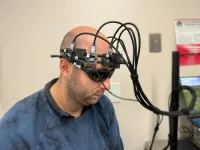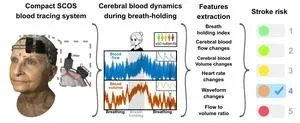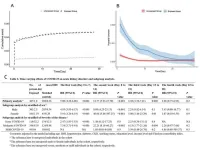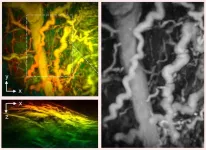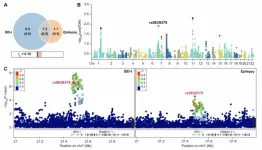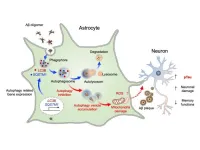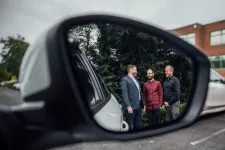(Press-News.org) When physicians want to know more about a patient’s risk of cardiovascular disease, they can order a cardiac stress test. But when it comes to risk of stroke, there is no equivalent scalable and cost-effective test of the brain’s function to help physicians counsel patients on their potential risk. A questionnaire that asks patients about contributing risk factors is currently the best tool for estimating such risk.
Now a team of engineers and scientists from Caltech and the Keck School of Medicine of USC has developed a headset-based device that can be used to noninvasively assess a patient’s stroke risk by monitoring changes in blood flow and volume while a participant holds their breath. The device incorporates a laser-based system and has shown promising results in terms of differentiating between individuals at low and high risk of stroke.
Stroke affects nearly 800,000 Americans each year and is the leading cause of serious, long-term disability in the United States. It is caused by the blockage or rupture of an artery in the brain, which results in a reduction in blood flow. Starved of oxygen, the brain’s cells die rapidly—about 2 million every minute during a stroke.
"With this device, for the first time, we are going to have a way of knowing if the risk of someone having a stroke in the future is significant or not based on a physiological measurement," says Simon Mahler, a co-lead author of a paper describing the new technique and device in the journal Biomedical Optics Express and a postdoctoral scholar in the lab of Changhuei Yang, the Thomas G. Myers Professor of Electrical Engineering, Bioengineering, and Medical Engineering at Caltech and a Heritage Medical Research Institute Investigator. "We think this can really revolutionize the way stroke risk is assessed and will eventually help doctors determine if a patient’s risk is stable or worsening."
"Our optical technology to noninvasively measure blood flow is expected to be useful for a number of brain disease applications," says Yang, who is also the executive officer for electrical engineering at Caltech. He noted that this project is part of a larger collaboration effort with Dr. Charles Liu, professor of clinical neurological surgery, surgery, psychiatry and the behavioral sciences and biomedical engineering at the Keck School of Medicine of USC, and his team.
Speckle Contrast Optical Spectroscopy for Stroke-Risk Assessment
In general, blood vessels become stiffer as a person ages, meaning they have a harder time dilating to allow blood through. This, in turn, means the person is more prone to stroke.
The Caltech team developed a compact device that shines infrared laser light through the skull and into the brain in one location and then uses a special camera nearby to collect the light that bounces back after it is scattered by blood flowing within the blood vessels. The approach, called speckle contrast optical spectroscopy (SCOS), measures the decrease in the light’s intensity from the spot where it enters the skull to the place where the bounced-back light is collected to determine the volume of blood in the brain’s blood vessels; it also looks at the way light scatters and creates speckles in the camera’s field of view. The speckles fluctuate in images depending on the rate of blood flow in the blood vessels. The faster the blood is flowing, the more rapidly the speckle field changes.
The researchers can use those measurements to calculate a ratio of the flow over the volume of blood streaming through the vessel to get an idea of that patient’s stroke risk.
The team conducted a study of 50 participants. They used the currently used stroke risk questionnaire, the Cleveland Stroke Risk Calculator, to divide the participants into two groups: one low risk and one high risk. They then measured blood flow in each volunteer for three minutes, quantifying the flow rate and volume of blood reaching the brain. After one minute, they asked the participants to hold their breath.
Holding your breath stresses your brain as it begins to notice that it is taking in too much carbon dioxide and not enough oxygen. It goes into what Mahler refers to as "panic mode," and starts to pump oxygen from the rest of the body to itself. This greatly increases blood flow in the brain. Once you stop holding your breath, oxygen levels return to baseline. While this happens in both people at low and high risk of stroke, the researchers found that there were differences between the groups in terms of how the blood moved through the vessels.
The SCOS technique allows the researchers to measure how much the blood vessels expand while the subject holds their breath and how much faster blood flows through the vessels in response. "These reactive measurements are indicative of vessel stiffness," Yang says. "Our technology makes it possible to make these type of measurements noninvasively for the first time."
The Findings
“What we found is clear, striking evidence of a different reaction of blood flow and blood volume between the two groups," says Yu Xi Huang, a co-lead author of the new paper and a graduate student in Yang’s lab.
In the low-stroke-risk group, the researchers observed a smaller increase in blood flow during the breath-holding exercise compared to the high-stroke-risk group, but a greater increase in blood volume—an indication that more blood is able to flow through the widened blood vessels.
"We can clearly see that the higher risk group has a higher flow-to-volume ratio, where they have faster flow but a lower volume of blood during breath holding,” Mahler says. This is caused by the stiffness of the blood vessels and indicates a higher chance of rupture. "If someone came in with an extremely high flow-to-volume ratio value, we might suspect that this person will have a stroke in the near future."
A Promising Future
The team is conducting additional research using the current prototype of the imaging device on patients at a hospital in Visalia, California, to gather additional data from a larger, more diverse population. The researchers also plan to incorporate machine learning into the device’s data collection process and to conduct a clinical trial that would involve patient tracking over more than two years to enhance the technology. They hope the device might eventually be used broadly not only for stroke risk prescreening but also to help detect where exactly in the brain a stroke might have already occurred.
Additional authors on the paper, "Correlating stroke risk with non-invasive cerebrovascular perfusion dynamics using a portable speckle contrast optical spectroscopy laser device," are Julian Michael Tyszka, associate director of the Caltech Brain Imaging Center; and Dr. Aidin Abedi, Yu Tung Lo, Patrick D. Lyden, and Dr. Jonathan Russin of the Keck School of Medicine of USC. The work was supported by the National Institutes of Health and the USC Neurorestoration Center.
END
New laser-based headset can measure blood flow, assess risk of stroke
Device offers first affordable, portable method for differentiating stroke risk based on physiological conditions
2024-09-30
ELSE PRESS RELEASES FROM THIS DATE:
Researchers close in on understanding possible cause of Alzheimer’s disease
2024-09-30
CLEVELAND—With a four-year, $3.3 million grant from the National Institutes of Health (NIH), researchers from Case Western Reserve University will study whether certain brain proteins may play a role in the development of Alzheimer’s disease.
Alzheimer’s disease is a brain disorder that slowly destroys memory and thinking skills. According to the Alzheimer’s Association, nearly 7 million Americans 65 and older are living with the disease and there are more deaths from Alzheimer’s than breast and prostate cancer combined.
Previous research has ...
New synthesis strategy could speed up PFAS decontamination
2024-09-30
HOUSTON – (Sept. 30, 2024) – Rice University engineers have developed an innovative way to make covalent organic frameworks (COFs), special materials that can be used to trap gases, filter water and speed up chemical reactions. COFs have the potential to address significant environmental challenges, including energy storage and pollution control. An example of that is their potential use in the decontamination of “forever chemicals” or per- and polyfluoroalkyl substances (PFAS).
Rice chemical engineer Rafael Verduzco and his team have described a new way to synthesize high-quality ...
COVID-19 linked to increased risk of acute kidney disorders: New study reveals time-varying effects
2024-09-30
Researchers from West China Hospital, Sichuan University, have conducted a study revealing a significant association between COVID-19 and acute kidney disorders (AKD), including acute kidney injury (AKI), that varies over time. The study, led by Dr. Li Chunyang and Dr. Zeng Xiaoxi from the West China Biomedical Big Data Center, was recently published in the journal Health Data Science.
COVID-19, known for its impact on the respiratory system, also affects other organs, including the kidneys. The study aimed to investigate the time-dependent effects of COVID-19 on acute kidney disorders. Using data from the ...
Medical imaging breakthrough could transform cancer and arthritis diagnosis
2024-09-30
A new hand-held scanner developed by UCL researchers can generate highly detailed 3D photoacoustic images in just seconds, paving the way for their use in a clinical setting for the first time and offering the potential for earlier disease diagnosis.
In the study, published in Nature Biomedical Engineering, the team show their technology can deliver photoacoustic tomography (PAT) imaging scans to doctors in real time, providing them with accurate and intricate images of blood vessels, helping inform patient care.
Photoacoustic ...
Genetic link between bipolar disorder and epilepsy unveiled in groundbreaking study
2024-09-30
Kunming, China - A team of researchers from the Chinese Academy of Sciences has uncovered compelling evidence of a genetic link between bipolar disorder type I (BD-I) and epilepsy, potentially revolutionizing our understanding of these complex neuropsychiatric conditions. The study, published in Genomic Psychiatry on September 30, 2024, reveals shared genetic variants and a causal relationship between the two disorders, opening new avenues for research and treatment.
Led by Dr. Ming Li from the Kunming ...
Social networks help people resolve welfare problems - but only sometimes, new research finds
2024-09-30
Lead researcher Dr Sarah Nason, from Bangor University’s School of History, Law and Social Sciences explained: “Debt, benefits, special educational needs, healthcare issues, these are everyday problems that many of us face, and it’s only natural to turn to people you know and trust for help and advice. However, we found that having to talk to more people or support services was an indicator that the problem was more complex and difficult to resolve.”
The team studied four distinct areas across England and Wales: Bryngwran, a village on Anglesey in North Wales; Deeplish, a district of Rochdale in Greater ...
Honey, I shrunk the city: What should declining Japanese cities do?
2024-09-30
Aging societies and population decline have been on the rise globally, but in Japan, the situation has exasperated tenfold. A staggering 36.21 million people, or 28.9% of the populace, are 65 and over. Further, 74.6% of Japan’s 1,747 cities are categorized as shrinking, with urban policies struggling to keep up with the decline. However, the factors that correlate with population changes in cities of varying sizes have not been clarified.
Dr. Haruka Kato, a junior associate professor at Osaka Metropolitan University, ...
New brain cell cleaner: astrocytes raise possibility of Alzheimer’s disease treatment
2024-09-30
A research team led by Dr. Hoon Ryu from the Korea Institute of Science and Technology (KIST, President Sang-Rok Oh) Brain Disease Research Group, in collaboration with Director Justin C. Lee of the Institute for Basic Science (IBS, President Do-Young Noh) and Professor Junghee Lee from Boston University Chobanian & Avedisian School of Medicine, has uncovered a new mechanism involving astrocytes for treating Alzheimer’s disease (AD) and proposed a novel therapeutic target. In this study, the researchers revealed that autophagy pathway ...
American Academy of Pediatrics announces its first clinical practice guideline for opioid prescriptions
2024-09-30
Media contacts:
Lisa Robinson, lrobinson@aap.org
Alex Hulvalchick, ahulvalchick@aap.org
American Academy of Pediatrics Announces its First Clinical Practice Guideline for Opioid Prescriptions
Pediatricians should prescribe opioids for pain when necessary, with recommended precautions in place to increase safety, according to a clinical practice guideline released during the AAP 2024 National Conference & Exhibition
ORLANDO, Fla.--The American Academy of Pediatrics has published its first clinical ...
Drivers of electric vehicles are more likely to be at fault in road traffic crashes than drivers of petrol and diesel cars
2024-09-30
Drivers of electric vehicles (EVs) are more likely to be involved in at-fault road traffic accidents than drivers of petrol and diesel cars, research by Lero, the Research Ireland Centre for Software, at University of Limerick and Universitat de Barcelona, reveals.
In the analysis of insurance claims and data from onboard sensors, due to be published in the November issue of the journal Accident Analysis & Prevention, the Lero researchers reveal a number of key findings:
Electric and hybrid drivers exhibit different behaviours ...
LAST 30 PRESS RELEASES:
Researchers use robotics to find potential new antibiotic among hundreds of metal complexes
Gut bacteria changes at the earliest stages of inflammatory bowel disease
Scientists develop new way to “listen in” on the brain’s hidden language
Brain research: “Pulse generators” grow and shrink as memories are formed
For teens, any cannabis use may have impact on emotional health, academic performance
School meals could unlock major gains for human and planetary health
Menopause hormone therapy does not appear to impact dementia risk
Signature patterns of brain activity may help predict recovery from traumatic brain injury
Dresden study uncovers new key mechanism in cancer cells
New species are now being discovered faster than ever before, study suggests
Cannabis-based products show limited short-term benefit for chronic pain, with increased risk of adverse effects
Cannabis products with more THC slightly reduce pain but cause more side effects
Clearing the brain of aging cells could aid epilepsy and reduce seizures
Brain injuries linked with potential risk of suicide, new study finds
New technique lights up where drugs go in the body, cell by cell
New study finds movement of fishing fleets can reveal shifts in marine ecosystems
Embargoed: New evidence points to potential treatment for vascular dementia
Study uncovers disrupted brain balance in alcohol dependence
Working in groups can help Republicans and Democrats agree on controversial content moderation online
Structural findings reveal how distinct GPCR ligands create different levels of activation
Anything-goes “anyons” may be at the root of surprising quantum experiments
UC review: Maximizing workplace opportunity for veterans
From generation to complex control: Metasurfaces make perfect vortex beams "within reach"
Thin-film lithium niobate-based detector: recent advances and perspectives
Exploring why some people may tend to persistently make bad choices
How cells balance their protein levels
Nirsevimab vs RSVpreF vaccine for RSV–related hospitalization in newborns
Effectiveness and impact of maternal RSV immunization and nirsevimab on medically attended RSV in US children
AI gives scientists a boost, but at the cost of too many mediocre papers
Next-generation vision model maps tree growth at sub-meter precision
[Press-News.org] New laser-based headset can measure blood flow, assess risk of strokeDevice offers first affordable, portable method for differentiating stroke risk based on physiological conditions
